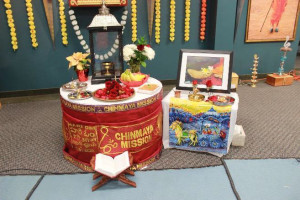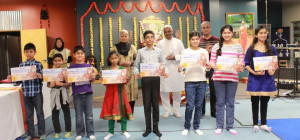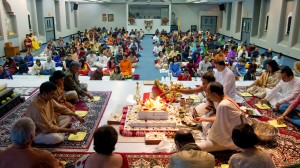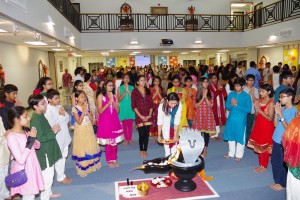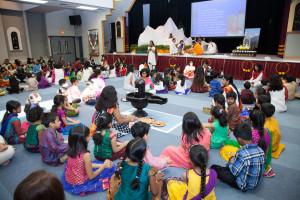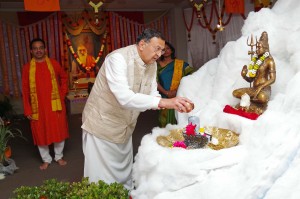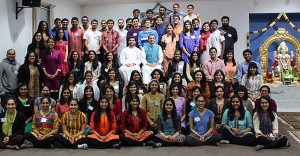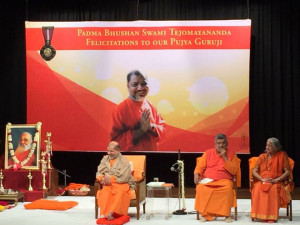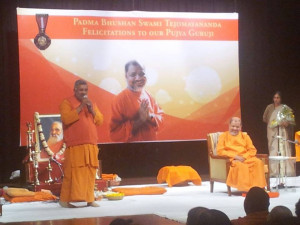Author Archives: Web Master
Activities in Bengaluru – December 2015
Chinmaya Birth Centenary Celebrations
Pujya Br Sujay Chaitanya of Mangalore centre conducted a Jnana Yajna at Jnana Jyoti Educational Trust, Yelahanka in English from 30/11/2015 to 06/12/2015 taking Sadhana Panchakam in the evenings. The Yajna was inaugurated by the children of Balvihar. Hunting for happiness in the wrong place man in his ignorance is seeking the same in the wrong places getting bound to the world again and again. There needs to be a perfect clarity in all our sadhanas which should purify the mind leading to destruction of self ignorance realising that the world is an illusion and ‘I’ am beyond the body. A realised master without kartrutva and bhoktrutva bhava rooted in the Atman with his Ego totally destroyed continues to work selflessly in the outer world for the benefit of society exhausting his prarabdha with a smile. The Yajna was well attended.
Pujya Swami Adityananda of Mandya centre conducted a Gita Jnana Yajna in Kannada from 30/11/2015 to 06/12/2015 at Prarthana Mandir, Chinmaya Vidyalaya, Koramangala taking Bhagavad Gita chapter 9. The Yajna was inaugurated by Sri K M Rajagopal, senior member of the mission. Pujya Swamiji explained the importance of visualizing the Lord in all situations and surrender to His will to lead a meaningful life. A real sadhak should not get attracted by the outer world and strive to live beyond the realm of body, mind and intellect getting rooted firmly in the knowledge that there is nothing beyond the Self. The Yajna was well attended.
Pujya Swami Krutatmananda of Sripaadakshetra, J P Nagar conducted a Jnana Yajna in Kannada from 14/12/2015 to 20/12/2015 at Shirdi Sai Mandir, Tyagarajanagar taking the values as appearing in Bhagavad Gita Chapter 13. The Yajna was inaugurated by Sri Seshadri, president of Sai Adhyatma Centre. Swamiji took the values in detail explaining the importance of inculcating them in one’s life to lead a purposeful life. All Mahatmas inspite of having realised the supreme truth led a simple and humble life spreading joy and happiness all round them. It is the basic values which they practised that brought fragrance to their teachings. The Yajna was well attended.
Pujya Br. Sujay Chaitanya of Mangalore centre conducted a Gita Jnana Yajna in English on Meditation techniques based on Bhagavad Gita Chapter 6 f at Sri Vinayaka Temple, R T Nagar from 24/12/2015 to 30/12/2015. The Yajna was inaugurated by Sri Ananth Raj Padubidri, patron of the temple. Pujya Sujayji explained in detail how meditation helps the sadhak in taming not only the mind but also the senses so that the complex body, mind, intellect instrument available can be used for sadhana and evolution to develop an integrated personality. The techniques explained in the Bhagavad Gita represent the essence of detachment and attain the supreme truth that external objects of the world do not give peace of mind which is one’s own real nature. The Yajna was well attended.
Kartika Masa special puja was performed at Sripaadakshetra on 06/12/2015 with bhajans and Rudrabhisheka followed by satsang on Shiva Mahimna Stotram by Pujya Swami Brahmananda. Words cannot explain the glory of Lord Shiva who can be understood only when one transcends the BMI gaining perfect control over the senses and understands the true nature of Self with right knowledge and understanding. The entire month saw the temple decorated with lights every evening with regular Satsang, Bhajans and cultural programmes and attended by thousands of devotees from all over the city.
Sri G Aswathanarayan, IAS who served as Chief Executive of Chinmaya Mission Hospital for the past 15 years expressed desire to be relieved and a fitting warm and affectionate farewell was accorded to him on Sunday, December 6, 2015 at Sripaadakshetra, J P Nagar in the holy presence of Pujya Swami Brahmananda and the trustees of Karnataka Chinmaya Seva Trust and witnessed by hundreds of Chinmaya family members. All trustees including Pujya Swami Brahmananda remembered the contribution of Sri Aswathanarayan in transforming a sick institution to unbelievable heights of glory through sheer dedication and hard work. A hard core administrator he did not leave any stone unturned in bringing out revolutionary reforms at all levels in administration, finance, personal, customer relations and modernisation. He was able to successfully weed out the negative forces and put the hospital on development phase converting a small 50 bed hospital into a multi specialty ultra modern 300 bed hospital with all ultra modern facilities under one roof.
Pujya Swami Brahmananda held a satsang on Essence of Bhagavad Gita at Sri Chandrashekara Bharathi Kalyan Mandir, Shankarapuram on 25/12/2015 in connection with Sri Rama Samrajya Pattabhisheka celeberations. All our epics including Ramayana revolve around basic moralities of life as preached in the Bhagavad Gita. The values observed by every character in the Ramayana stand testimony to the various yogas explained by the Lord in the Bhagavad Gita. The ultimate message is to realise the impermanence of the body and external world and dwell in the cosmic truth that Self alone prevails and all else is just a mirage.
Pujya Swami Ishwarananda, Director of Chinmaya Mission West overseeing the operations in North America conducted a satsang on Kulashekara Alwar’s Mukunda Mala on 31/12/2015 at Deenabandhu Kalia Mardhana Krishna temple, Indiranagar. The meaning of devotion as observed by Kulashekar Alwar is not just worship of an idol but total surrender to the will of the Lord not allowing the Ego to raise its hood under any circumstance. It is a total and clear understanding that Thy sankalpa will prevail and ‘I’ am just a flute in His hands.
Paduka Pujas in 1000 houses has picked up momemtum with almost 800 Paduka Pujas completed as on 31/12/2015.
Chinmaya Bharati – Ottawa (CANADA) December 2015
The last month at Chinmaya Bharati we welcomed and housed the Chinmaya Jyoti for a short four weeks. During that time, the centre seemed to glow a new glow and was vibrant with activities. From the day the Jyoti arrived to the day the Jyoti left for the next location, everyday there was movement in the centre and brought us together for numerous events.
The first few weeks were filled with classes in the evenings. Weeknights were filled with either the Devi group taking Bhaja Govindam, a study group for Gurudev’s Logic of Spirituality, bhajan groups, Bhagavad Geeta classes, or families participating in Paduka Poojas. The center was filled with new and old members of all age groups getting involved. On weekends, balavihar classes were packed and children worked hard in their final practices for the Geeta Chanting Competition.
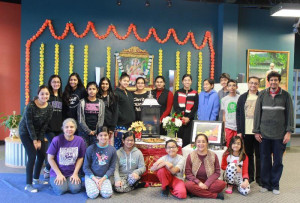 As the month continued forward, activities picked up even more, with an overnight youth sleepover camp on the Chinmaya Mission Pledge. The high schoolers filled their minds with Vedanta, enjoyed team work activities and games, and of course ate lots of wonderful food.
As the month continued forward, activities picked up even more, with an overnight youth sleepover camp on the Chinmaya Mission Pledge. The high schoolers filled their minds with Vedanta, enjoyed team work activities and games, and of course ate lots of wonderful food.
A few days later, the long awaited Geeta Chanting Competition took place. Over 15 children came in nervous yet very prepared and tons of spectators sat in the audience to cheer them on. The children of ages 4-16 had been practicing and memorizing Geeta Chapter 15, perfecting their pronunciation and mastering the tune. When the competition began, all were in shock to see how well the children were doing. Jaws were dropping and everyone was excited for the whole evening.
For me, this was the highlight of the month. Swami Chinmayananda’s greatest contribution to people everywhere was the Bhagavad Geeta and he is known all over the world for his commentary and teachings in English on this text. Watching children from such a young age, mastering one chapter from the Geeta and chanting it with gusto, felt like it was very much unto Him. It was a good wrap-up of activities at Chinmaya Bharati for the month having the Chinmaya Jyoti with us.

Overall, the Chinmaya Jyoti symbolized togetherness and helped me to visualize the vastness of the Chinmaya family. To see the Jyoti travel across the world from huge centres like Los Angeles to small townships like Minden, Ontario, was a heartwarming experience. Although I never met Swami Chinmayananda, witnessing events of such magnitude such as the Chinmaya Jyoti Yatra, helps me to know him better. From seeing devotees willingly travel on a long journey to Boston to bring the Jyoti to Chinmaya Bharati, to listening to stories of Gurudev from members at the centre, to watching people conduct paduka poojas with utmost devotion and love, to smiling through the “Moods of the Master” video on the final evening of the Jyoti in Ottawa, I learn more and more about the greatness of Gurudev, and I feel more and more blessed to be a part of such an organization and to continue to follow under His guidance. It was an honouring experience to be involved in such a big movement, and the whole Chinmaya Ottawa family really did attempt to respect our promise of “Unto HIM our best.”
Value-based education is the only solution
A value-based education system deeply rooted in the eternal rich Indian culture and civilization alone is the only solution to the apparent problem of diminishing moral values among the new generation, opined Swami Swaroopananda, the Director of the prestigious Chinmaya International Residential School in Coimbatore, India who is also the Regional Head of Chinmaya Mission Australia, United Kingdom and the Far East.
A familiar visitor to Bahrain, he was in the Kingdom to deliver a series of talks titled ‘Reshape Your Destiny’ from February 18 to 22 at Bahrain Society of Engineers Hall, Juffair. The event was organized by Chinmaya Society Bahrain as a part of the year-long celebrations during this 100th birth centenary of Swami Chinmayananda, spiritual leader and teacher who inspired the formation of Chinmaya Mission, a worldwide nonprofit organization, formed to spread the knowledge of Advaita Vedanta, the non-dual system of thought found in the Upanishads, which epitomise the philosophical teachings of the Vedas.
According to Swami Swaroopananda, value-based education promotes effective learning and underpins the continuous improvement of personal, professional, social, national and spiritual wellbeing of an individual. Most of us think that education is only for employment, whereas we must understand that education is basically for empowerment and ultimately for enlightenment. It provides you with the basic strength and support to survive in the world, and teaches you to learn lessons so as to lead a life of success and satisfaction. If you are well educated, you become independent to take up various tasks by yourself without depending on others. It provides you basic confidence and you can survive in any part of the world. Education serves as a launching pad for your career and life. A school should provide a safe, positive, intense learning environment that will empower students to become creative problem solvers, critical thinkers, and inspired learners for their future careers and life in the twenty- first century.
The purpose of education is to make students capable of living their lives fully at all levels of their personalities. They should be able to face the numerous challenges of life and carve out a purposeful future for themselves.
Chinmaya Residential schools groom students in noble cultural values and create a thirst for greater knowledge in them, so that they discover the mysteries of nature and the world around them, said Swami Swaroopananda.
The resounding success of the Chinmaya Education Movement, based on the much acclaimed Chinmaya Vision Program, has been primarily due to its unique vision of offering academic education complemented with spiritual knowledge, he added.
Source of Upanishads – The Vedas
Knowledge of the Self is called upanishad vidya and the scriptural texts, in which it is revealed, are called the Upanishads.
The Upanishads, in the form of granthas or books, may be many; but the Self knowledge revealed by them is one and the same. Only that knowledge which is revealed in the Vedas, and not written by anyone, is Upanishad.
Vedas – Authentic Means of Knowledge
The Upanishad texts are found in the Vedas. The word Veda comes from the root vid – knowledge.
The Vedas are not written by any rishi; they contain truths that were revealed to the great rishis in their seat of meditation. These mantras are the Lord’s revelations and, therefore, the rishis are called the Seers of these mantras – mantra drstaraha, na tu mantra kartaraha.
Truly speaking all knowledge is always revealed. Thereafter, it is expressed in words and put in writing by the person to whom it is revealed. Irrespective of the field, Truth is always revealed. For example, Newton’s Law of Gravitation was not something original conceived by him. This law of nature was revealed to him; it was discovered by him. Subsequently, he explained it in detail and many others also carried out experiments to substantiate his findings.
Why Study the Vedas?
In today’s scientific world and modern temper, people question the need of studying the Vedas. Here two things have been pointed out. Firstly it is said ,Vedas are required for those who want to know what is dharma and adharma. Secondly, the Vedas are the means of knowledge for those who want to know what is Brahman, what is the Absolute Truth, which cannot be directly perceived or experimented upon in a laboratory.
The Vedas are not needed to study astronomy or physiology, though that knowledge also may be found in them. They are the authentic and valid means of knowing the Supreme Truth. They can also be regarded as a treasure of knowledge.
Two Categories of Upanishads
It is said that there are 108 Upanishads, but they are not all available to us. There are eleven important Upanishads which are considered the major Upanishads, while some others are categorised as minor Upanishads.
As far as the content is concerned, there is no difference between them. Both reveal the same Truth. So how do they differ? The major Upanishads are those on which great acharyas of different traditions have written bhasyas (commentaries). Having studied them, it becomes possible to understand the others as well.
One Mirror is Enough
Often, people wonder how many Upanishads one needs to study in order to gain Self-Knowledge.
Once, a mahatma was asked this frequent question. He replied, ‘How many mirrors do you need to see your face? One mirror is enough. Of course, there is no harm if you wish to see it in many mirrors. Every mirror will only show a reflection of your own self.’
Similarly, to gain the Self knowledge, the study of one Upanishad is sufficient; but if one wishes to revel in it and enjoy it, one may study many more.
When a Realised Master was asked why he still continued to read the Upanishads, he replied that he was just reading about his own glories! ‘Anorniyan mahato mahiyan – I (the Self) am greater than the greatest and subtler than the subtlest.’
That is why we love to see images of ourselves because we see, unconsciously, the reflection of our true nature, our blissful and lovable Self.
The Author is the Head of Chinmaya Mission Worldwide. This is Blog 4 in the Upanishads series.
Swami Prashantanandaji attains Mahasamadhi
Hari Om!
One of our senior Swamis, Swami Prashantanandaji attained Mahasamadhi in the Ashram in Rewa at 03.30 AM on 4th April, 2016.
Swamiji’s funeral will take place tomorrow, 5th April, 2016 at Rewa and shodashi will be held at our Tapovan Kuti, Uttarkashi Ashram on 19th April, 2016.
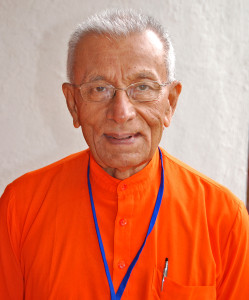
More details will follow.
With Prem & Om,
Tejomayananda
No Price is Too High
Having gone through various experiences and seen the purposelessness and hollowness of life, one approaches a Teacher, upa, with nishcaya. What exactly does nischaya mean? It indicates that the student must approach the Teacher with the firm determination that he or she has to gain this knowledge at any cost and is willing to make any sacrifice to do so. This attitude is called nishcaya and is indicated by ‘ni’ in the word ‘Upanishad’. It is a very important qualification.
A Fit Student
Unless one is ready to renounce and sacrifice, no progress is possible – in any field of life. Often, the words ‘renounce’ and ‘sacrifice’ frighten people. But if the advantages are pointed out, they may not seem so fearful. Sacrifice and renunciation take us to prosperity and growth. Nothing can be gained without giving up what one was holding on to earlier. If we insist on retaining our false notions, it will not be possible to know the Truth. They must be rejected.
Maximum courage is required to face the truth. A student once approached a master and requested initiation. The master asked, ‘If I tell you that this Truth is bitter and will destroy your present life, will you still be willing to know it? Do you want to know the Truth for its own sake or to gain worldly success? The student responded that he was eager to know the Truth, even though it would destroy his life in its existing form.
A person who has such intense longing and is ready to pay any price is a qualified student.
Generally, people are interested in the Bhagavad Gita and other scriptures only to benefit in worldly matters. For example, a man thought that by attending Gita study classes, he would get a promotion. When he did not get it, he stopped attending the class! Success occurs if one works sincerely in the spirit of the Gita – not by not working and just coming to classes!
During exams, we see many students praying at the neighbourhood temple. They pray that they may pass, even though they have not studied for it. This is how the mind works.
Humility and Service
The Guru is a jnani, an enlightened person established in his Knowledge, and the student is a jignyasu, a seeker of Knowledge, eager to know. The student sits at the feet of the Teacher – shad. Even in life it is observed that water flows easily from a higher to a lower level; to pump water up to a higher level is difficult.
Sitting at the feet of the Guru represents an attitude of humility, service and devotion. The flow of knowledge becomes easier. When the student sits humbly at the feet of the Teacher, serves him and is eager to know, the Teacher teaches and the student gains knowledge.
Upanishad as Knowledge
The word ‘Upanishad’ itself means vidya, knowledge and not a particular book. Since the book, which is in the form of words, also reveals that Knowledge, it is called Upanishad. This is a simple explanation of the word.
Now let us see the deeper meaning. The word ‘shad’ also means destruction. This Knowledge results in avidya nasha – destruction of ignorance and all bondage that is created as a result of it. All false notions and concepts are eliminated .
The other meaning is that all bondages are loosened (visharana). The enlightened person seems to live like an ordinary person and also goes through physical suffering.
Hanumanji appeared to be was bound by Meghnada in Lanka; when he wanted to escape, he cast off his bonds and set about burning the city. In the same way, an enlightened person appears to be bound by the body or by society and seems to be suffering, but in reality, he is not bound.
With the dawn of knowledge, ignorance is destroyed, bondages are loosened and the person ‘sees’ his own true nature – his ananda svarupa.
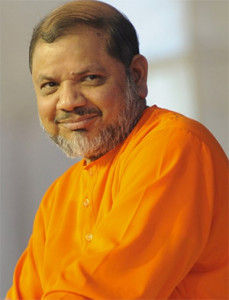
The Author is the Global Head of Chinmaya Mission Worldwide.
A unique and symbolic Mahasivaratri at Chinmaya Prabha
Lord Siva, the ideal of auspiciousness, was invoked at Chinmaya Prabha and Sri Saumyakasi Sivalaya in a weeklong Mahasivaratri celebration that began on March 6th and culminated on March 13, 2016. Befitting the holiest time of worship of the great three-eyed Lord, the celebrations were highlighted by three events – a unique Rudra puja performed exclusively by over 700 Bala Vihar children; a sacred and traditional Sivaratri when thousands participated in Ksirabhisekam, ritualistic worship, and Vedic chanting; and a reverential Maha Mrtyunjaya Homam offered by a multitude of devotees for the health and spiritual prosperity of the world at large.
On March 6th, the many adorably sincere children of Chinmaya Bala Vihar were the unforgettable leaders who flagged off this year’s Sivaratri celebration. The enthusiastic and eager young devotees from kindergarten through 12th grade individually performed the intricately nuanced rituals of the Rudram Puja following flawlessly the seemingly complex Sanskrit Vedic chants that were described in a concise narrative. The students were guided step by step in offering the symbolic sixteen-step pujas for Lord Ganesa and Lord Siva with Shobha Ravishankar giving appropriate references to the meaning behind each action. A thoughtfully designed Power Point presentation creatively interwove the ancient and majestic verses and conveyed to impressionable minds the powerful purpose of puja.
Sri Ganeshji, the priest of Sri Saumyakasi Sivalaya, then continued to energize the elaborate puja with his powerful chanting of the ancient Rudram. Immersed in the sacred vibrations of the Rudram, parents and adults witnessed children perform abhisekam to beautifully majestic Sivalingas made with great love and devotion by sincere teachers, room parents, and many Chinmaya mission volunteers. As each class of children sat around their special Sivalingas and made garlands and wrote “Om Namah Sivaya” on the bilva leaves in revered silence, it was an entrancing sight to behold. When all those hundreds of young voices chanted “Om Namah Sivaya” 108 times at the end of the Rudra puja, it was as though the entire Chinmaya Prabha was uplifted to a realm beyond words.
Watching the young generation involve themselves with such sincere purity in the puja that spanned over an hour, it felt as if the hundreds of Balavihar students had been magically transported to a gurukula in ancient India to perform the sacred rituals in their presence of their gurus and elders. With the support of Acarya Gaurang Nanavaty, Acarya Darshana Nanavaty’s love, care and vision for her Balavihar students was actualized by her inspired team of dedicated teachers and sevakas who used artistry and technology to inspire spirituality.
With that spirited beginning, an endless and steady stream of devotees began arriving at the Sri Saumyakasi Sivalaya temple to celebrate Mahasivaratri on March 7th. Visitors numbered in the thousands from the rich and diverse mosaic of the Indian American community in Houston as evidenced by the array of Indian languages heard in the soft conversations that wafted in the evening breeze.
Arriving families were respectfully ushered into the temple courtyard where they formed long lines. As the evening advanced, the lines grew longer and the skies grew darker with storm clouds. From a distance, the canopies installed outside the temple with their peaks looked like the distant Himalayan ranges on a stormy night. The stronger the wind gusts got, the more vibrantly the row of orange flags fluttered. Ensconced within this scene, the Sivalaya stood out like the veritable Kailas, resplendent with lights that outlined the temple and illuminated by the flood lights that surrounded the courtyard and temple.
The continuous melodious chanting of ‘Om Namah Sivaya’ instilled a contemplative hue on the premises. When devotees reached the Tapovan room, they performed ksirabisekam (milk offering) to the Sivalinga kept there, bowed to portrait of Gurudev Swami Chinmayananda, and prayed to the pratima of Lord Ganesa. Thus, with minds purified, devotees made their way up the steps to Sri Saumyakasi Sivalaya for darsana of the meditative Lord Siva. There, Sri Ganeshji and a team of other priests led the Ekadasa Rudrabhisekams, chanting the sacred Hindu verses in a spiritual symphony and immersing the entire environs in the holy glow of spirituality. With the dedicated efforts of a sincere team of volunteers, it was as if the Sri Saumyakasi temple and all present were transported in time and space into a Mahasivaratri puja in ancient India. The auspicious abhisekams were followed by melodious bhajanas that concluded with an arati.
As the midnight hour approached, all became quiet for an hour of meditation. The lights were turned down, and deep silence permeated the surroundings like the stillness of calm waters. It was time for all thoughts to cease, for stillness and peace to connect the soul to Siva in that matchless experience in the Sivalaya on Mahasivaratri.
To extend Sivaratri worship into a heartfelt prayer for the maximum happiness for all, the culminating event of Mahamrtyunjaya Homam was performed in the Chinmaya Smrti hall of Chinmaya Prabha on March 13th. Once again, hundreds of devotees congregated to pray for the well-being of the world, chanting the great Mahamrtyunjaya mantra a significant 108 times during the ceremony. The selfless prayer sanctified the atmosphere; as this year’s Sivaratri celebrations concluded, it felt like everyone was encircled in the great graceful presence of Lord Siva.
For more information on Chinmaya Mission Houston, Sri Saumyakasi Sivalaya and its activities visit www.chinmayahouston.org, www.saumyakasi.org or call temple 281 568 1690 or Jay Deshmukh 832 541 0059 or Bharati Sutaria 281-933-0233
2016 Annual Chicago CHYK Retreat
Every year, the Chinmaya Mission Chicago Center CHYKs bring together a group of young adults to discuss the most important thing in life: understanding our true nature. The CHYK camps serve as a safe space to explore our inner musings & to lift each other up through clarified knowledge and collective courage. To do this, we turn to the timeless scriptures & extract what they mean today and how they can be applied in daily life. This year, the retreat explored the topic of the ‘Universal Guru Within’ by studying the Guru Stotram under Vivekji from Niagara Falls & Manisha Panchakam under Dhirenji from Chicago.
Vivekji and Dhirenji guided us on not only the meaning of the texts as written but also offered tactile takeaway points that can be practiced such as “listen more” and “schedule contemplation.” Their underlying message was that while we need a guru to point us in the right direction, we must also look within ourselves to follow that path. The lectures were followed by discussions, Q&A and personal reflections. The weekend was interspersed with meditation, yoga, frisbee, storytelling, and most importantly, great food. Retreats like this offer a supportive environment to be honest with ourselves, realize what truly matters in life and inspire us to spread that happiness wherever we go. We hope that you will join us in Chicago next year to press pause, become a little more conscious and aware, and resume life again with a renewed meaning.
Felicitation Ceremony on 14th February at the Delhi Centre
Pujya Guruji being honoured with the Padma Bhushan award by the Government of India is a matter of great pride and joy for the entire Chinmaya Mission family.
An acknowledgement of his undiluted love and leadership qualities, it is a tribute to the vision of Pujya Gurudev and the work of the Chinmaya Mission worldwide.
The Delhi Center was extremely fortunate to have Guruji in Delhi on the 14th February and like a kind and loving parent kindly agreed to celebrate this great milestone with Chinmaya members in Delhi NCR.
Swami Nikhilananda compared the life and qualities of Pujya Guruji with the confluence of the three sacred rivers – Ganga the symbol of devotion, Yamuna of action and Saraswati of knowledge.
Speaking on the occasion Guruji said the sanyasi on embracing the order of sanyas relinquishes all titles but he has received such awards and titles. The Padma Bhushan is one more in the series. On another note he opined that the giver must be humble and the receiver grateful. When the sanyasi has identified with the whole then the award is an acknowledgement of the work of Pujya Gurudev and Chinmaya Mission.
The evening began with a Paduka Puja and ended with Gurudev’s arati. All in all the evening left the hall full of Chinmaya followers with indelible memories to mull over and carry home.
